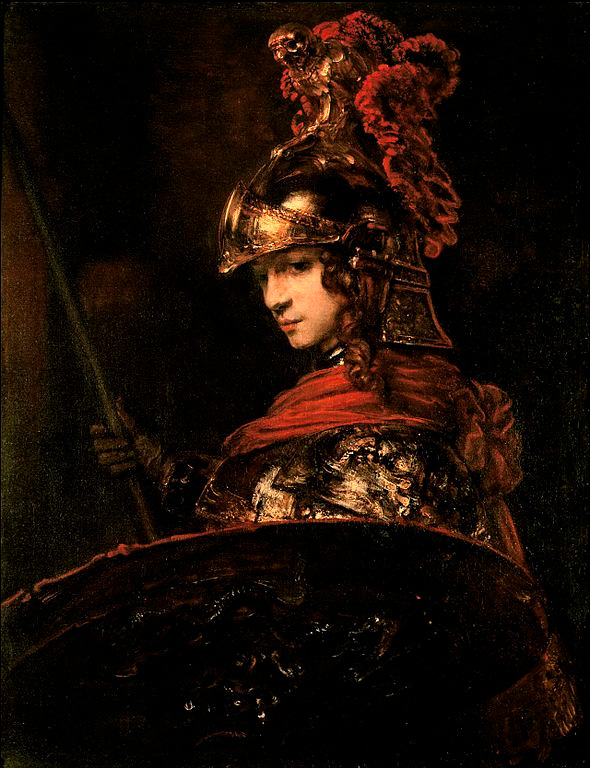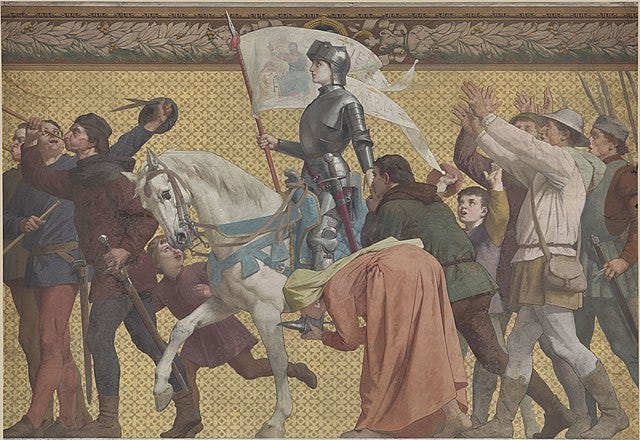Ancient Women Warriors
Uncovering myth and reality behind some of history’s most inspiring and enigmatic stories of heroism
Editor’s Note: This article is a bit longer than the usual Classically Cultured piece. Feel free to read a section or two at a time. But make sure to eventually make your way to the last story featuring the Amazons. Those ladies never disappoint :)
A dive into ancient texts opens up a world of heroism to the reader. From Homer’s trickster tales featuring a sly and cunning hero to the virtuous Titan gods who battled with Zeus and his army for dominion over the heavens, these stories leap off pages and into our spirits. They teach us how to spot a good tale. Even more, they instill in us a sense of right and wrong, of virtues to follow and vices to reject, and how to treat our fellow mankind.
Today, I will cover just a few of ancient history’s most inspiring female figures. Because there are too many for just one article, I’ve narrowed the list down to feature women warriors of the distant past. While they lived and died long before any of us were ever brought into the world, their exciting stories, passion for life, courage in the face of adversity, and love for humanity keeps their spirits alive. Their virtuous wisdom shrinks the distance between past and present. And their enduring legacies give us hope for the future.
Read on to learn about the legends and real-life battles of some of history’s most exhilarating women warriors.
Athena
Daughter of Zeus and protector of Ancient Greek cities, one of mythology’s most popular goddesses remains an integral part of western cultures even thousands of years after she, as the tale goes, sprang from Zeus’ forehead when she came to life.
Goddess of practical wisdom and warfare, Greeks long associated her with the city of Athens, which she protected with her strength, wit, and keen sense regarding the art of war. She appears in two of Ancient Greece’s most notable works, the Iliad and the Odyssey, both epic poems written by one of history’s earliest known writers, Homer.
Often depicted with a helmet and spear, Athena’s fearless and striking image is still portrayed through modern character archetypes in contemporary times.
She is regarded as one of the earliest depictions of heroism that transcends sex or class ranking. Similar to Ancient Greece, in modern times Athena is recognized as a democratic figure representing freedom for all who are just and virtuous.
Joan of Arc
When I was around eight years old, my mother gave me a copy of a Joan of Arc biography. What a precious gift this was. From that point on, the young commander’s courage, leadership, charisma, and faith would serve as guiding principles for me.
It is hard to believe a 17 year old peasant girl could lead a volunteer army sporting thousands of unpaid men to defeat a British siege against the French city of Orleans, but that’s exactly what Joan did.
While kings viewed her foray into battle as a death sentence, guided by justice and faith, Joan calmly led her band of ragtag soldiers into chaos. Though they were outmatched and overpowered, in a true David versus Goliath scenario, they won.
Many important lessons can be learned from Joan’s unyielding character. But perhaps the most telling triumph is the fact that in 1429, thousands of men voluntarily signed up for Joan’s cause, without pay. Only someone of great moral standing leading a charge against injustice in the midst of a seemingly unwinnable war could compel everyday citizens to join the fight.
While Joan is known for her skill in battle and unshakeable spirit, sometimes an overlooked aspect of her character was her ability to connect with people. The men who fought with her were honored to go into battle alongside her, and her reputation emboldened entire cities to emancipate themselves from fear and fight for freedom.
Kings’ lackeys tried to throw her off course time and again by jailing her, endlessly questioning her, and even dressing up in everyday garb to avoid talking with her when she requested counsel.
None of their tricks, or at times inhumane tactics, worked.
The embodiment of courage and evergreen faith, Joan d’Arc eventually became a patron saint of France, and an example of moral fortitude anyone can admire and seek to embody themselves.
Boudica
“I am descended from mighty men! But I am not fighting for my kingdom and wealth now. I am fighting as an ordinary person for my lost freedom…”
Most of what we know about one of Britain’s historic commanding queens is thanks to the work of Tacitus, a Roman historian who documented Boudica’s final battle in his work, Annals of Rome. The most notable figure who had to deal with this relentless Britain royal-turned-warrior was the famous libertine emperor of Rome, Niro.
Ruler of the Iceni in East Anglia along with her husband King Prasutagus, Boudica’s tribe was just one of many in that region in 60 AD. Despite the sizes and territory covered by these tribes, the empire of Rome was closing in on them.
Prasutagus tried to take a more diplomatic approach, but he was outsmarted by the Romans several times. By the time he died, Rome stood ready to gobble up the Iceni’s land along with other territories around it.
When they ransacked the ancient Britain tribe, Roman officers stole the property of villagers, flogged Boudica publicly, and had her two daughters assaulted. Despite the horrendous torture Boudica, her daughters, and the rest of the village underwent, their spirit was not broken. And that had a lot to do with how Boudica reacted.
Instead of bowing down to their new oppressors, she launched a revolt, and plenty joined up with her. They won several battles and gained ground that had previously been controlled by Roman forces. Before long, it appeared they were on the cusp of beating the Romans and re-establishing their autonomy.
By 61 AD, Boudica and her army stood ready for their ultimate battle at the “Midlands of England.” This is where she gave her famous, eloquent speech recorded by Tacitus. While her proud words gave her men the push they needed to fight with honor, the Roman army was too powerful. Despite a valiant effort, the Iceni and their fellow tribes were subdued.
Though she wasn’t killed in battle, Boudica opted for poison after the war, vowing to never kneel before Roman rule no matter what.
To this day, this ancient warrior queen holds a special place in UK history. Not only is she known as a historic Celtic figure (her fiery red hair and fierce attitude are classic Celt traits), she is also known as one of Great Britain’s bravest heroes. A bronze statue of her constructed in 1902 resides on the Thames River near the House of Parliament.
The Amazons
One sunny day, a group of male warriors quietly watched a band of peculiar women from the safety of tall grass along the steppes near what is now the Black Sea. The tall, muscular women were on horseback, with bows and arrows slung across their backs. From the looks of their apparent leisure, the male warriors concluded the women had stopped for a brief respite before continuing on their journey.
Intrigued, the men decided to slowly make their way towards the tribe. They moved deliberately, trying their best not to scare the women they yearned to learn more about. Much to their shock and amazement, when the women spotted the men moving toward them, they didn’t retreat. Instead, they met them head on, friendly yet controlled, and went about their business as the men observed them.
This unique experience compelled the male warriors to spend several days with this female faction, following along on horseback as they made their way through vast rural plains. Along the journey, the women revealed to the men their expertise in archery, hunting, horsemanship, and comradery.
Finally, enamored with their skill and self-mastery, the warriors worked up the nerve to ask the women to follow them back to their home, where their elders resided. Their one-of-a-kind presence would serve as a definite entertaining treat to their non-nomadic brethren.
The warriors were initially dismayed at the womens’ refusal. But, when they asked them to continue on their journey with them to their eventual destination, the men felt a renewed spark and decided to tag along.
So, the newly formed tribe made their way further along the open range along the Black Sea. Eventually, the female travelers grew fond of their male mates and struck up romantic relationships with them. They hunted with them, shared food with them, and ultimately had babies with them.
Exactly where their story ends noone is sure. But that makes it all the more beautiful. To us, this co-ed nomadic family is still roaming the steppes, still infatuated with each other’s near otherworldly differences, still roaming their side of the world together, with more babies on the way.
This enduring tale featuring just one of several female-oriented Amazon tribes is brilliantly retold in Adrienne Mayor’s authoritative book, The Amazons. The tour de force separates myth from reality in regards to this puzzling piece of ancient history, and does so via scientific discoveries made during archaeological excavations, many of which Mayor was a part of.
While Wonder Woman would have you believe Amazons were an all-female culture living on a mythic, mountainous island, what we now know thanks to scientific advancement and rigor of professionals like Mayor, is that the Amazons were a collection of nomadic tribes who covered vast territory thanks to their skill on horseback. From the shores of the Black Sea through Russia, Ukraine, the Middle East, and even into Asia, Amazon women (and men) were scattered about everywhere in ancient times.
They were fierce warriors, often buried with their weapons and horses. Only since the early 2000s did technological advancement allow us to definitively decipher the sex of bones. What scientists surprisingly discovered is just how many women warriors there actually were.
As we widen the scope of scientific discovery through historic artifacts, we widen the scope of humanity, showing that women and men have always been capable of breaking convention and living freely, even if it’s not adequately covered in a text book.
For many, the Amazons are still viewed as the Greeks viewed them, mythic creatures to be observed and fantasized about from afar. The Amazons and their expertise in battle were often depicted on Ancient Greek vases. The Amazon women warriors fought valiantly against their Greek male counterparts, and though the Greeks always beat them in their epic myths, the artists made sure to depict the women dying a nobel death.
Aristotle spent much time on remote islands, studying plant and animal life that would ultimately give him the title, “Father of Biology.” Did he come across a wandering Amazon tribe during his escapades?
Much like the male warriors from our story earlier, Greek men were enamored with Amazon myths and tales.
But based on all the new evidence compiled in Mayor’s book and coming to light more each day, was it really fantasy being portrayed on all those ornate Greek vases?
Just like the archeologists discovering Amazon burial grounds across former Eurasia, the deeper one digs on this subject, the more truth is revealed. But just as they were hard to catch on horseback, they remain elusive, the realities buried within their myth hard to grasp and relay to the contemporary reader. This makes a fitting and thought-provoking continuation of the Amazon tribes’ ever-evasive legacy.
The “Rebecca Day Originals Collection” page is officially live and I’m populating it more everyday. Check out my band The Crazy Daysies, and some of our most popular work. We will be releasing our latest single, ‘Burn Out This Flame,’ right here, exclusively on Substack, before anywhere else!







